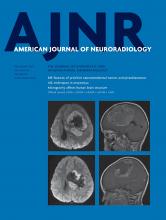Index by author
Laine, M.
- Pediatric NeuroimagingYou have accessSusceptibility-Weighted Imaging Findings in AspartylglucosaminuriaA. Tokola, M. Laine, R. Tikkanen and T. AuttiAmerican Journal of Neuroradiology November 2019, 40 (11) 1850-1854; DOI: https://doi.org/10.3174/ajnr.A6288
Leclerc, X.
- Pediatric NeuroimagingYou have accessBiometry of the Cerebellar Vermis and Brain Stem in Children: MR Imaging Reference Data from Measurements in 718 ChildrenC. Jandeaux, G. Kuchcinski, C. Ternynck, A. Riquet, X. Leclerc, J.-P. Pruvo and G. Soto-AresAmerican Journal of Neuroradiology November 2019, 40 (11) 1835-1841; DOI: https://doi.org/10.3174/ajnr.A6257
Lee, T.C.
- Head and Neck ImagingOpen AccessMR Imaging of the Extracranial Facial Nerve with the CISS SequenceJ.P. Guenette, N. Ben-Shlomo, J. Jayender, R.T. Seethamraju, V. Kimbrell, N.-A. Tran, R.Y. Huang, C.J. Kim, J.I. Kass, C.E. Corrales and T.C. LeeAmerican Journal of Neuroradiology November 2019, 40 (11) 1954-1959; DOI: https://doi.org/10.3174/ajnr.A6261
Lehman, V.T.
- FELLOWS' JOURNAL CLUBPatient SafetyOpen AccessEvaluation of Lower-Dose Spiral Head CT for Detection of Intracranial Findings Causing Neurologic DeficitsJ.G. Fletcher, D.R. DeLone, A.L. Kotsenas, N.G. Campeau, V.T. Lehman, L. Yu, S. Leng, D.R. Holmes, P.K. Edwards, M.P. Johnson, G.J. Michalak, R.E. Carter and C.H. McColloughAmerican Journal of Neuroradiology November 2019, 40 (11) 1855-1863; DOI: https://doi.org/10.3174/ajnr.A6251
Projection data from 83 patients undergoing unenhanced spiral head CT for suspected neurologic deficits were collected. A routine dose was obtained using 250 effective mAs and iterative reconstruction. Lower-dose configurations were reconstructed (25-effective mAs iterative reconstruction, 50-effective mAs filtered back-projection and iterative reconstruction, 100-effective mAs filtered back-projection and iterative reconstruction, 200-effective mAs filtered back-projection). Three neuroradiologists circled findings, indicating diagnosis, confidence, and image quality. The routine-dose jackknife alternative free-response receiver operating characteristic figure of merit was 0.87. Noninferiority was shown for 100-effective mAs iterative reconstruction and 200-effective mAs filtered back-projection, but not for100-effective mAs filtered back-projection. The authors conclude that substantial opportunity exists for dose reduction using spiral nonenhanced head CT and that the dose level might potentially be reduced to 40% of routine dose levels or a volume CT dose index of approximately 15mGy if slight decreases in performance are acceptable. The beneficial effect of iterative reconstrution was most pronounced at this 15-mGy dose level.
Leng, S.
- FELLOWS' JOURNAL CLUBPatient SafetyOpen AccessEvaluation of Lower-Dose Spiral Head CT for Detection of Intracranial Findings Causing Neurologic DeficitsJ.G. Fletcher, D.R. DeLone, A.L. Kotsenas, N.G. Campeau, V.T. Lehman, L. Yu, S. Leng, D.R. Holmes, P.K. Edwards, M.P. Johnson, G.J. Michalak, R.E. Carter and C.H. McColloughAmerican Journal of Neuroradiology November 2019, 40 (11) 1855-1863; DOI: https://doi.org/10.3174/ajnr.A6251
Projection data from 83 patients undergoing unenhanced spiral head CT for suspected neurologic deficits were collected. A routine dose was obtained using 250 effective mAs and iterative reconstruction. Lower-dose configurations were reconstructed (25-effective mAs iterative reconstruction, 50-effective mAs filtered back-projection and iterative reconstruction, 100-effective mAs filtered back-projection and iterative reconstruction, 200-effective mAs filtered back-projection). Three neuroradiologists circled findings, indicating diagnosis, confidence, and image quality. The routine-dose jackknife alternative free-response receiver operating characteristic figure of merit was 0.87. Noninferiority was shown for 100-effective mAs iterative reconstruction and 200-effective mAs filtered back-projection, but not for100-effective mAs filtered back-projection. The authors conclude that substantial opportunity exists for dose reduction using spiral nonenhanced head CT and that the dose level might potentially be reduced to 40% of routine dose levels or a volume CT dose index of approximately 15mGy if slight decreases in performance are acceptable. The beneficial effect of iterative reconstrution was most pronounced at this 15-mGy dose level.
Lequin, M.
- Pediatric NeuroimagingOpen AccessSignal Change in the Mammillary Bodies after Perinatal AsphyxiaM. Molavi, S.D. Vann, L.S. de Vries, F. Groenendaal and M. LequinAmerican Journal of Neuroradiology November 2019, 40 (11) 1829-1834; DOI: https://doi.org/10.3174/ajnr.A6232
Levy, R.
- FELLOWS' JOURNAL CLUBPediatric NeuroimagingYou have accessIncidental Brain MRI Findings in Children: A Systematic Review and Meta-AnalysisV. Dangouloff-Ros, C.-J. Roux, G. Boulouis, R. Levy, N. Nicolas, C. Lozach, D. Grevent, F. Brunelle, N. Boddaert and O. NaggaraAmerican Journal of Neuroradiology November 2019, 40 (11) 1818-1823; DOI: https://doi.org/10.3174/ajnr.A6281
Seven studies were included, reporting 5938 children (mean age, 11.3 ± 2.8 years). Incidental findings were present in 16.4% of healthy children, intracranial cysts being the most frequent (10.2%). Nonspecific white matter hyperintensities were reported in 1.9%, Chiari I malformation was found in 0.8%, and intracranial neoplasms were reported in 0.2%. In total, the prevalence of incidental findings needing follow-up was 2.6%. The prevalence of incidental findings is much more frequent in children than previously reported in adults, but clinically significant incidental findings were present in <1 in 38 children.
Li, M.-L.
- Adult BrainOpen AccessMiddle Cerebral Artery Plaque Hyperintensity on T2-Weighted Vessel Wall Imaging Is Associated with Ischemic StrokeY.-N. Yu, M.-W. Liu, J.P. Villablanca, M.-L. Li, Y.-Y. Xu, S. Gao, F. Feng, D.S. Liebeskind, F. Scalzo and W.-H. XuAmerican Journal of Neuroradiology November 2019, 40 (11) 1886-1892; DOI: https://doi.org/10.3174/ajnr.A6260
Li, R.
- Adult BrainYou have accessRole of 3D Pseudocontinuous Arterial Spin-Labeling Perfusion in the Diagnosis and Follow-Up in Patients with Herpes Simplex EncephalitisR. Li, P.-A. Shi, T.-F. Liu, Y. Li, Y. Wang, K. Wu, X.-J. Chen, H.-F. Xiao, Y.-L. Wang, L. Ma and X. LouAmerican Journal of Neuroradiology November 2019, 40 (11) 1901-1907; DOI: https://doi.org/10.3174/ajnr.A6279
Li, W.
- EDITOR'S CHOICENeurointerventionOpen AccessHemodynamic Analysis of Postoperative Rupture of Unruptured Intracranial Aneurysms after Placement of Flow-Diverting Stents: A Matched Case-Control StudyW. Li, Z. Tian, W. Zhu, Y.S. Zhang, K. Wang, Y. Zhang, Y. Wang, X. Yang and J. LiuAmerican Journal of Neuroradiology November 2019, 40 (11) 1916-1923; DOI: https://doi.org/10.3174/ajnr.A6256
The authors enrolled 10 patients with intracranial aneurysms, treated with flow diverters between September 2014 and December 2018, who experienced postoperative aneurysm rupture. They matched these subjects 1:2 with 20 with postoperative unruptured intracranial aneurysms based on clinical and morphologic factors. Using computational fluid dynamics, they assessed hemodynamic changes pre- and posttreatment between the 2 groups on a number of qualitative and quantitative parameters. Compared with pretreatment, unstable flow pattern and higher energy loss after Pipeline Embolization Device placement for intracranial aneurysm may be the important hemodynamic risk factors related to delayed aneurysm rupture.








